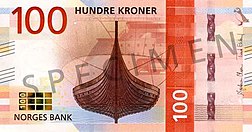Norwegian krone
National currency of Norway / From Wikipedia, the free encyclopedia
Dear Wikiwand AI, let's keep it short by simply answering these key questions:
Can you list the top facts and stats about Norwegian krone?
Summarize this article for a 10 year old
The krone (Norwegian: [ˈkrûːnə], abbreviation: kr (also NKr for distinction); code: NOK), plural kroner, is the currency of the Kingdom of Norway (including overseas territories and dependencies). It was traditionally known as the Norwegian crown in English; however, this has fallen out of common usage. It is nominally subdivided into 100 øre, although the last coins denominated in øre were withdrawn in 2012.
| Norsk krone (Norwegian) | |
|---|---|
 100 kroner banknote obverse | |
| ISO 4217 | |
| Code | NOK (numeric: 578) |
| Subunit | 0.01 |
| Unit | |
| Plural | kroner |
| Symbol | kr |
| Denominations | |
| Subunit | |
| 1⁄100 | øre |
| Plural | |
| øre | øre |
| Banknotes | |
| Freq. used | 50, 100, 200, 500 kroner |
| Rarely used | 1000 kroner |
| Coins | 1, 5, 10, 20 kroner |
| Demographics | |
| Date of introduction | 1875 (1875) |
| Replaced | Norwegian speciedaler |
| User(s) | |
| Issuance | |
| Central bank | Norges Bank |
| Website | www |
| Valuation | |
| Inflation | 5.4% (April 2022) |
| Source | Norges bank |
The krone was the thirteenth-most-traded currency in the world by value in April 2010, down three positions from 2007.[1]
The Norwegian krone is also informally accepted in many shops in Sweden and Finland that are close to the Norwegian border, and also in some shops in the Danish ferry ports of Hirtshals and Frederikshavn. Norwegians spent 14.1 billion NOK on border shopping in 2015 compared to 10.5 billion NOK spent in 2010. Border shopping is a fairly common practice amongst Norwegians, though it is seldom done on impulse. Money is spent mainly on food articles, alcohol, and tobacco, in that order, usually in bulk or large quantities. This is due to considerably higher taxes and fees on tobacco and alcohol purchased domestically in Norway.[2][3]